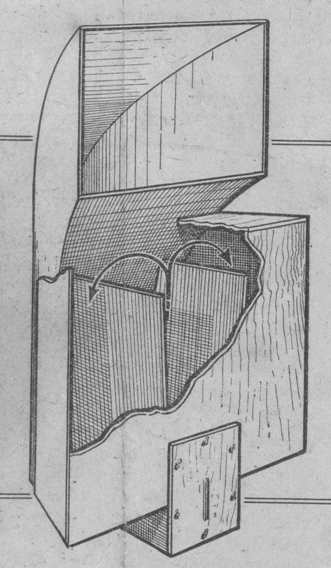
Here's a really nice link!
Paul Voigt was the developer of what we now know as the Lowther drive units. These are developed a bit further, but much of their design is as it was in the thirties. While there are other strategies for fullrange drivers with high efficiency (ie smaller or larger diameter, without whizzer cone, different materials, different suspension characteristics), the Lowther school is still highly respected and led to other drivers following a similar strategy. AER and Fostex come to kind, Feastrex as well.
Paul Voigt initially put these drivers in large frontloaded horns. There were large, ready made, furniture grade cabinets, but also a DIY kit to be built from plans, pictured here. Whether he designed the drivers to be placed in horns, or designed the horns to make the drivers work, I don't know, but the end result is the same. This type of drivers has a response curve and a suspension type that works best in a frontloaded horn. By this, I mean that there is more treble and a general decline in lower frequency response. The horn boosts the lower frequencies and restores balance. The horn also reduces distortion, damps resonances in the driver, and gives that horn flavour that counts (even if only psychologically). In principal, you can apply this to any low Qts driver with a tilted frequency response.
Modern examples of large horns for these drivers, are the Oris range of horns by BD-Design. I have used Lowthers in "official" backloaded horn designs and was quite happy with the results, but after hearing a full-tilt Oris system at the BD-Design audition room, I started making fronthorns for my Lowthers as well. The positive effect of front hornloading was strong, expect a more dynamic, relaxed and controlled sound.
Back to the Lowther Voigt Museum. Basic horn formulae haven't changed much since the days of Paul Voigt, the application of these rules has. Nevertheless, it is very interesting to see these old designs and meditate on the creative use of knowledge of the time. Even if you don't build a Home Constructor Horn, it is noteworthy that Voigt obviously saw an advantage to using a large frontloaded horn, as opposed to say a backloaded horn, or use a smaller fronthorn to go with the TQWT/resonant pipe. Apart from this, it's just cool to see some pieces of historical significane.
The website offers some history of the company and persons, it gives pictures and descriptions of products and. apparently, the museum also sells copies of brochures and plans.
http://www.lowthervoigtmuseum.org.uk/index.html
Paul Voigt was the developer of what we now know as the Lowther drive units. These are developed a bit further, but much of their design is as it was in the thirties. While there are other strategies for fullrange drivers with high efficiency (ie smaller or larger diameter, without whizzer cone, different materials, different suspension characteristics), the Lowther school is still highly respected and led to other drivers following a similar strategy. AER and Fostex come to kind, Feastrex as well.
Paul Voigt initially put these drivers in large frontloaded horns. There were large, ready made, furniture grade cabinets, but also a DIY kit to be built from plans, pictured here. Whether he designed the drivers to be placed in horns, or designed the horns to make the drivers work, I don't know, but the end result is the same. This type of drivers has a response curve and a suspension type that works best in a frontloaded horn. By this, I mean that there is more treble and a general decline in lower frequency response. The horn boosts the lower frequencies and restores balance. The horn also reduces distortion, damps resonances in the driver, and gives that horn flavour that counts (even if only psychologically). In principal, you can apply this to any low Qts driver with a tilted frequency response.
Modern examples of large horns for these drivers, are the Oris range of horns by BD-Design. I have used Lowthers in "official" backloaded horn designs and was quite happy with the results, but after hearing a full-tilt Oris system at the BD-Design audition room, I started making fronthorns for my Lowthers as well. The positive effect of front hornloading was strong, expect a more dynamic, relaxed and controlled sound.
Back to the Lowther Voigt Museum. Basic horn formulae haven't changed much since the days of Paul Voigt, the application of these rules has. Nevertheless, it is very interesting to see these old designs and meditate on the creative use of knowledge of the time. Even if you don't build a Home Constructor Horn, it is noteworthy that Voigt obviously saw an advantage to using a large frontloaded horn, as opposed to say a backloaded horn, or use a smaller fronthorn to go with the TQWT/resonant pipe. Apart from this, it's just cool to see some pieces of historical significane.
The website offers some history of the company and persons, it gives pictures and descriptions of products and. apparently, the museum also sells copies of brochures and plans.
http://www.lowthervoigtmuseum.org.uk/index.html
2 comments:
The Nimbus straight circular Horn was said to be very good - was it Tratrix or expo ? Did it have a bass chamber ? if it did - was it in sync with the front wave? HAPPY HEARING & A HAPPY 2013. guy.
Dear Pat, I don't know the Nimbus horn, so I cannot answer your questions. Sorry.
Post a Comment